-

人教版新目标初中英语九年级下册By the time I got outside, the bus had already left教案
Ⅰ. Teaching Aims and Demands1. Knowledge Objects(1) Key Vocabularyoversleep(2) Target LanguageWhat happened?I overslept. And by the time I got up, my brother had already gotten in the shower.2. Ability Objects(1) Teach the students to use the new words.(2) Train the students to narrate past events with the Past Perfect Tense.(3) Train the students' listening and speaking skills with the target language.3. Moral ObjectIt’s a good habit to go to bed early in the evening and get up early in the morning. So you’ll never be in a hurry in the morning.Ⅱ. Teaching Key Points1. Key Vocabularyoversleep2. Target LanguageNarrate past events with the Past Perfect TenseⅢ. Teaching Difficult Points1. Train the students to narrate past events with the Past Perfect Tense.2. Train the students to understand the target language in spoken conversation.Ⅳ. Teaching Methods1. Thinking of examples from the students' real lives.2. Making sentences by looking at the pictures.Ⅴ. Teaching AidA tape recorderⅥ. Teaching ProceduresStep I Revision1. Revise the language points in Unit 8.Ask some questions like this: What volunteer work would you like to do?Help the students to answer, I’d like to…/I love to…/I hope to2. Practice the dialogue in Activity 3c on page 62 again. Get students to role play the similar dialogues with the following.

人教版新目标初中英语九年级上册It must belong to Carla教案
一、Section A该部分有4个模块。第一模块围绕Whose volleyball is this? 这一话题展开思维( 1a)、听力(1b)、口语( 1c)训练;第二模块围绕上一模块中的话题进行听力( 2a-2b)、口语训练( 2c);第三模块继续围绕前两个模块中的“making inferences”展开训练。训练形式为阅读排序( 3a)和两人问答(3b);第四模块仍就上一话题展开讨论。二、Section B该部分有4个模块。第一模块要求根据图画和所提供的单词写出合理的句子;第二模块在听力( 2a-2b)和分角色口语训练( 2c)的基础上,继续进行“推测”训练; 第三模块围绕“Strange events in Bell Tower neighborhood”这一话题展开阅读( 3a)和写作(3b -3c)训练;第四模块以dream为话题展开小组活动。三、Self Check该部分有3个模块。第一模块以填空形式对所学词汇进行训练;第二模块就8个谚语展开阅读和讨论。

人教版新目标初中英语九年级上册Where would you like to visit教案2篇
The First PeriodⅠ.Teaching Aims and DemandsKnowledge Objects(1) Key Vocabularytiring, educational, fascinating, thrilling, peaceful, exotic, trek, jungle, take it easy, explore, historic, site(2) Target LanguageWhere would you like to go on vacation?I’d like to trek through the jungle, because I like exciting vacations.2. Ability Objects(1)Train students to talk about places they would like to visit with the target language.(2)Train students to describe vacations with different adjectives.(3)Train students' listening skill.3. Moral Object,It′s more interesting to go on vacating somewhere instead of staying at home.Ⅱ. Teaching Key Points1. Key Vocabularytiring, educational, fascinating, thrilling, peaceful, exotic, trek, jungle, take it easy, explore, historic, site2. Target LanguageTalk about different places with the target language.Ⅲ. Teaching Difficult Points1. Describe vacations with different adjectives.2. Talk about different places with the target language.Ⅳ. Teaching Methods1. Teaching by illumination2. Teaching by doing chain drills3. Teaching by pairworkⅤ. Teaching Aids1. A tape recorder2. Some pictures of different places with famous views

人教版新目标初中英语九年级下册Rainy days make me sad教案
1. 教材分析本单元以how do things affect you?为话题, 从颜色、天气、音乐、广告、产品等方面谈论了外界事物如何影响人的心情。要求学生掌握表达某物或某事给人带来的感觉、看法或影响等。共设计了四个部分的内容:Section A 该部分有4个模块:第一模块围绕Which restaurant would you like to go to?这一话题展开思维(1a)、听力(1b)、口语(1c)训练;第二模块围绕How does music affect you? 进行听力(2a-2b)、口语训练(2c);第三模块继续围绕how do colors in the restaurant affect you这一话题展开训练,训练形式为阅读和问题体验(3a)和小组活动(3b);第四模块仍就How do things affect you这一话题以调查的形式展开讨论。Section B该部分有4个模块:第一模块围绕产品广告对人们的影响这一话题以“配对”(1a)与“列举”(1b)两种形式展开训练;第二模块继续围绕How do things affect you? 进行听力(2a-2b)、口语对话训练(2c);第三模块围绕“Advertising”这一话题展开阅读(3a-3b)和写作(3c)训练;第四模块围绕How posters affect you这一话题以口语训练形式展开小组活动。

人教版新目标初中英语九年级下册Could you please tell me where the restrooms are教案
Step Ⅰ RevisionCheck homework. Ask a few students to read the article in 3a.Then ask a few students to read their guides.Step Ⅱ Part 1Look at the words in the box. Ask a student to read them. Make sure the students understand the meaning of the words. You are to fill in the blanks with the words. In some cases, students may need to use another form of the word, for example adjusting for tense or subject/ verb agreement.Ask students to fill in the blanks on their own.Check the answers. Step ⅢPart 2Go through the instructions with the class.Look at the example with the students.Ask students what the answer would be.Ask a student to read the question and answer it.Excuse me, could you tell me where the bank is, please?The bank is across the street from the shopping malt.Get students to complete the work in pairs.Check the answers. Ask a few students to read their questions.Step Ⅳ Just for Fun!Ask all the students to read the conversation. Ask: What is funny about this cartoon? Help students to explain. A Martian is a person from the planet Mars.There is no such thing as Martian food on Earth, and the clerk looks silly because he is trying to think of where there is a Martian restaurant.Invite some pairs of students to present this conversation to the rest of the class.Step Ⅴ Summary and HomeworkIn this class, we’ve done much writing practice using the key vocabulary words and the target language presented in this unit. After class, please finish the questions in 2 in your exercise books. Then finish the exercises on pages 47~48 of the workbook as well.The Seventh Period Ⅰ Teaching Aims and Demands1. Knowledge Objects(1) Key Vocabularyimage, adventure, jealousy, hero, crime, journey, brave, no longer, show interest in, take it easy, become interested in, plain looks(2)Text:Grown-ups like cartoons, too.2. Ability Objects(1) Fast-reading to get a general idea of the text.(2) Careful-reading to get the detailed information in the text.

人教版新目标初中英语九年级下册I’ll help clean up the city parks教案
Talk about offering help (P60)I’ll help clean up the city parks.A: I’d like to work ...B: You could help ...Talk about ways to tell people about the Clean-Up Day (P61)We need to ...We can’t ...I’ll ...Talk about the work the volunteers do (P62)These three students all volunteer their time to help other people.Somebody loves to ... / helps ... / plans to ... / wants to ...A: What do you like doing?B: I like ... A: What kind of volunteer work do you think I could do?B: You could ...1. 重点词汇advertisement, fix, repair, pleasure, blind, deaf, shut, carry, specially, fetch2. 认读词汇hunger, homeless, cheer, clean-up, sign, establish, major, commitment, elementary, veterinarian, coach, similar, call-in, strategy, disabled, organization, unable, support, appreciate, donation, part of speech, pronoun, adverb, preposition, conjunction, donate, Jimmy, Sally3. 词组clean up, cheer up, give out, put off, set up, think up, take after, fix up, give away, put up, hand out, work out, at once

人教版新目标初中英语九年级下册We’re trying to save the manatees教案2篇
本单元主要围绕着有关濒临灭绝的动物这一话题,学习了应该怎样保护我们的环境,以及就某一问题展开辩论。目标提示语言目标能够运用所学知识,就某一问题展开辩论。认知目标1、复习一些语法:现在进行时、一般现在时、用used to 表示一般过去时、现在完成时、一般过去时的被动语态。2、学会表达同意和不同意。3、学会以下基本句型:We’re trying to save the manatees.Manatees eat about 100 pounds of food a day.There used to be a lot of manatees.In 1972,it was discovered that they were endangered.Some of the swamps have become polluted.情感目标了解一些濒临灭绝的动物的生活习性和濒临灭绝的原因,教育学生应该如何保护环境。教学提示充分利用多媒体等教学设备,创设与本课话题相关的情境,如各种不同种类的动物、动物园以及有关环境的画画等等。围绕着本单元的教学目标,设计一些贴近学生实际的教学任务,如让学生谈论自己最喜欢的动物,如何拯救濒危动物,如何保护环境等等。让学生根据所学知识,就动物园是否对动物有利以及其他的话题进行辩论。

人教版新目标初中英语九年级下册You’re supposed to shake hands教案
教学目标:1. 掌握本单元一些重点词汇的写法和用法。2. 学会自如谈论餐桌礼仪。Step 1 RevisionAsk some students to retell the customs at the table in France in the passage in 3a.Step 2 Self checkPart 1. Fill in each bland with the correct word given. Students do the exercises by themselves at first. Then check the answers. Ask the students to comprehend the sentences and help them point out uses of some words, like “arrive (at / in) sw., spend time / money on sth , spend time / money (in) doing sth.”Part 2. Read about Fan Ling’s experience in a western restaurant. Understand the passage. Point out some key points in the passage.1. be / get used to doing sth. 习惯做某事2. begin with = start with 以….开头3. crowd v. 挤满,塞满 the crowd 人群 crowded adj. 拥挤的Then students discuss about how she would solve her problem. Ask some to share their stories with others.Part 3. Complete the crossword by looking at the sentences on the left. Then check the answers.
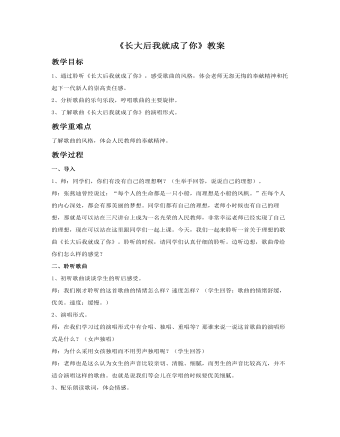
《长大后我就成了你》教案
教学过程一、导入1、师:同学们,你们有没有自己的理想啊?(生举手回答,说说自己的理想)。师:张燕迪曾经说过:“每个人的生命都是一只小船,而理想是小船的风帆。”在每个人的内心深处,都会有那美丽的梦想。同学们都有自己的理想,老师小时候也有自己的理想,那就是可以站在三尺讲台上成为一名光荣的人民教师,非常幸运老师已经实现了自己的理想,现在可以站在这里跟同学们一起上课。今天,我们一起来聆听一首关于理想的歌曲《长大后我就成了你》。聆听的时候,请同学们认真仔细的聆听。边听边想,歌曲带给你们怎么样的感觉?二、聆听歌曲1、初听歌曲谈谈学生的听后感受。师:我们刚才聆听的这首歌曲的情绪怎么样?速度怎样?(学生回答:歌曲的情绪舒缓,优美。速度:缓慢。)2、演唱形式。师:在我们学习过的演唱形式中有合唱、独唱、重唱等?那谁来说一说这首歌曲的演唱形式是什么?(女声独唱)师:为什么采用女孩独唱而不用男声独唱呢?(学生回答)师:老师也是这么认为女生的声音比较亲切、清脆、细腻,而男生的声音比较高亢,并不适合演唱这样的歌曲。也就是说我们等会儿在学唱的时候要优美细腻。3、配乐朗读歌词,体会情感。(1)配乐朗读第一段歌词。师:歌曲讲了一个怎么样的故事?生:歌曲中的主人公从小就非常喜欢自己的老师,也非常喜欢老师的这个职业。所以他梦想就长大后也可以成为一名光荣的人民教师。师:现在我们再来看看这首歌的歌词,它里面“长大后我就成立你”出现了几次?(2)师:同学们,从歌词的哪些词句中能看出是在描写或赞美老师呢?(那间教室,放飞的是希望,守巢的总是你。才知道那块黑板,写下的是真理,擦去的是功利。)
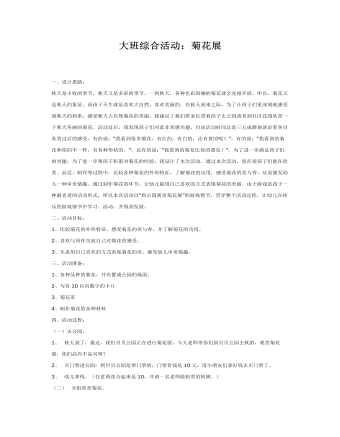
大班综合教案:菊花展
在秋天到来之际,为了让孩子们更深刻地感受到秋天的到来,感受秋天大自然菊花的美丽,我建议了我们班家长带着孩子去公园或者到社区花园欣赏一下秋天美丽的菊花。活动过后,我发现孩子们对此非常感兴趣,自由活动时间总是三五成群地谈论着各自欣赏过后的感受,有的说:“我看到很多菊花,有红的,有白的,还有黄的呢!”,有的说:“我看到的菊花和你的不一样,有各种形状的。”,还有的说:“我看到的菊花比你的漂亮!”。为了进一步满足孩子们的兴趣,为了进一步帮孩子积累对菊花的经验,我设计了本次活动。通过本次活动,意在使孩子们能在欣赏、品尝、制作等过程中,比较各种菊花的外形特征,了解菊花的功用,感受菊花的美与香,从而激发幼儿一种审美情趣。通过制作菊花的环节,让幼儿能用自己喜欢的方式表现菊花的美丽。由于游戏是孩子一种最喜爱的活动形式,所以本次活动以“到公园观赏菊花展”的游戏情节,贯穿整个活动过程,让幼儿在快乐的游戏情节中学习、活动,并得到发展。 二、活动目标: 1、比较菊花的外形特征,感受菊花的美与香,并了解菊花的功用。 2、喜欢与同伴交流自己对菊花的感受。 3、乐意用自己喜欢的方式表现菊花的美,激发幼儿审美情趣。
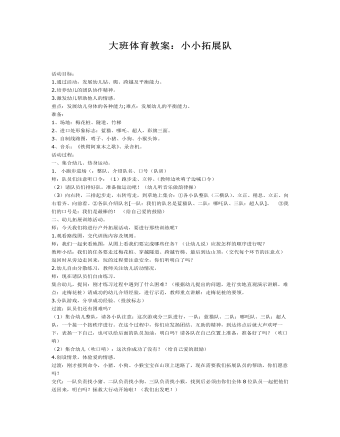
大班体育教案:小小拓展队
2.培养幼儿的团队协作精神。 3.激发幼儿帮助他人的情感。 重点:发展幼儿身体的各种能力;难点:发展幼儿的平衡能力。 准备: 1、场地:梅花桩、隧道、竹梯 2、进口处形象标志:蓝猫、哪吒、超人,彩旗三面。 3、自制线路图,哨子、小猪、小狗、小猴头饰。 4、音乐:《铁臂阿童木之歌》、录音机。 活动过程: 一、集合幼儿、热身运动。 1. 小跑步进场(:整队、介绍队名、口号(队训) 师:队员们注意听口令:(1)跑步走、立停。(教师边吹哨子边喊口令) (2)请队员们排好队,准备做运动吧!(幼儿听音乐做韵律操) (3)向右转,三排起步走,右转弯走,到草地上集合:①各小队整队(三横队)、立正、稍息、立正。向右看齐、向前看。②各队介绍队名[一队:我们的队名是蓝猫队、二队:哪吒队、三队:超人队]。③我们的口号是:我们是最棒的!(给自己爱的鼓励)
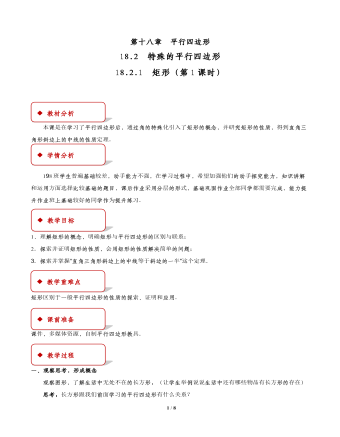
矩形第1课时教案
1. 理解矩形的概念,明确矩形与平行四边形的区别与联系;2.探索并证明矩形的性质,会用矩形的性质解决简单的问题;3.探索并掌握“直角三角形斜边上的中线等于斜边的一半”这个定理.
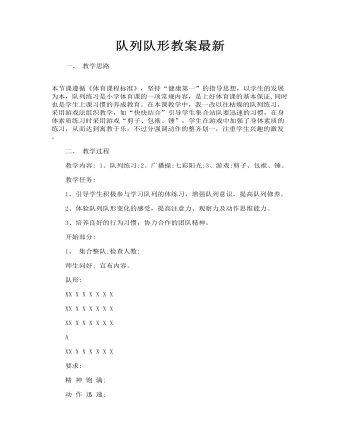
队列队形教案最新
二、 教学过程 教学内容: 1、队列练习;2、广播操:七彩阳光;3、游戏:剪子、包袱、锤。 教学任务: 1、引导学生积极参与学习队列的体练习,增强队列意识,提高队列修养。 2、体验队列队形变化的感受,提高注意力、观察力及动作思维能力。 3、培养良好的行为习惯,协力合作的团队精神。
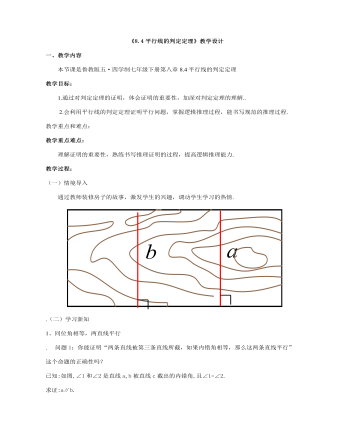
平行线的判定定理教案教学设计
问题1:你能证明“两条直线被第三条直线所截,如果内错角相等,那么这两条直线平行”这个命题的正确性吗?已知:如图,∠1和∠2是直线a,b被直线c截出的内错角,且∠1=∠2.求证:a∥b. 问题2:你能证明“两条直线被第三条直线所截,如果同旁内角互补,那么这两条直线平行”这个命题的正确性吗?已知:如图,∠1和∠2是直线a、b被直线c截出的同旁内角,且∠1与∠2互补.求证:a∥b
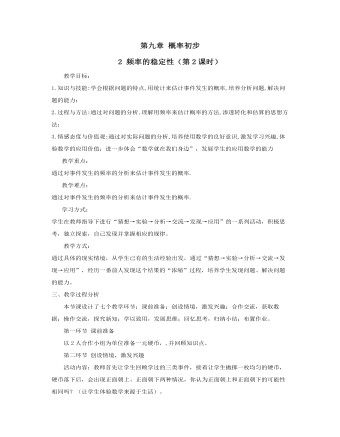
频率的稳定性教案教学设计
活动内容:教师首先让学生回顾学过的三类事件,接着让学生抛掷一枚均匀的硬币,硬币落下后,会出现正面朝上、正面朝下两种情况,你认为正面朝上和正面朝下的可能性相同吗?(让学生体验数学来源于生活)。活动目的:使学生回顾学过的三类事件,并由掷硬币游戏培养学生猜测游戏结果的能力,并从中初步体会猜测事件可能性。让学生体会猜测结果,这是很重要的一步,我们所学到的很多知识,都是先猜测,再经过多次的试验得出来的。而且由此引出猜测是需通过大量的实验来验证。这就是我们本节课要来研究的问题(自然引出课题)。
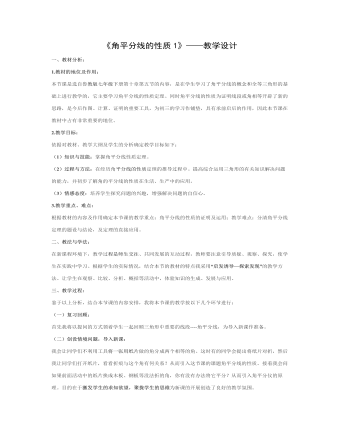
角平分线的性质教案教学设计
这是本节课的重点。让同学们将∠aob对折,再折出一个直角三角形(使第一条折痕为斜边),然后展开,请同学们观察并思考:后折叠的二条折痕的交点在什么地方?这两条折痕与角的两边有什么位置关系?这两条折痕在数量上有什么关系?这时有的同学会说:“角的平分线上的点到角的两边的距离相等”.即得到了角平分线的性质定理的猜想。接着我会让同学们理论证明,并转化为符号语言,注意分清题设和结论。有的同学会用全等三角形的判定定理aas证明,从而证明了猜想得到了角平分线的性质定理。
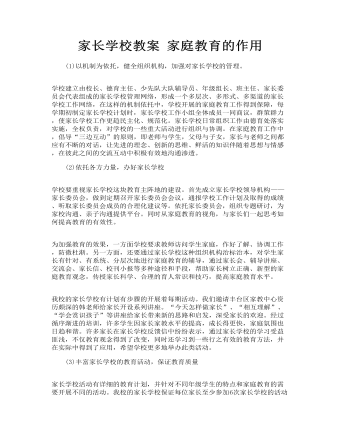
家长学校教案 家庭教育的作用
(2)依托各方力量,办好家长学校 学校要重视家长学校这块教育主阵地的建设。首先成立家长学校领导机构——家长委员会,做到定期召开家长委员会会议,通报学校工作计划及取得的成绩、听取家长委员会成员的合理化建议等。依托家长委员会,组织专题研讨,为家校沟通、亲子沟通提供平台。同时从家庭教育的视角,与家长们一起思考如何提高教育的有效性。 为加强教育的效果,一方面学校要求教师访问学生家庭,作好了解、协调工作,防微杜渐。另一方面,还要通过家长学校这种组织机构治标治本,对学生家长有针对、有系统、分层次地进行家庭教育的辅导,通过家长会、辅导讲座、交流会、家长信、校刊小报等多种途径和手段,帮助家长树立正确、新型的家庭教育观念,传授家长科学、合理的育人常识和技巧,提高家庭教育水平。
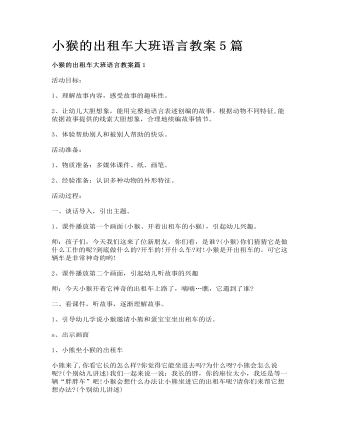
小猴的出租车大班语言教案5篇
1、讲述故事,加深理解。教师操作教具,讲述故事,穿插提问:a小猴发现蛋宝宝和小熊遇到什么困难?如果你是小猴你会怎样解决这个问题?请小朋友积极想办法。b小朋友听故事里的小猴是怎样做的。乘客对小猴设计的出租车是否“满意”(出示字卡满意),为什么?你们喜欢小猴和它的出租车吗?是否也“满意”?2、大胆想象仿编故事。引发仿编兴趣:小猴的名气越来越大了,森林里的小动物都来坐它的出租车。提问:长颈鹿和小刺猬遇到了什么困难?小猴是怎样解决的?森林里还有谁也乘坐小猴的出租车?他们可能遇到什么困难?小猴能解决吗?我们也帮小猴想想让所有的小动物都能顺利的乘坐出租车。(幼儿分组讨论,仿编故事,鼓励幼儿把故事讲给大家听。)
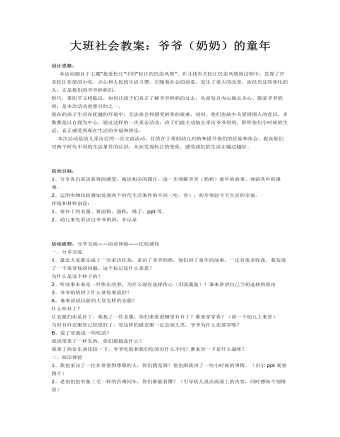
大班社会教案:爷爷(奶奶)的童年
活动目标:1、分享各自采访获得的感受,阅读相关的图片,进一步理解爷爷(奶奶)童年的故事,体验其中的艰难。2、运用实物比较感知发现两个时代生活条件的不同(吃、穿),初步体验今天生活的幸福。环境和材料创设:1、带补丁的衣服、黄面粉、蛋糕,绳子、ppt等。2、幼儿事先采访过爷爷奶奶,并记录
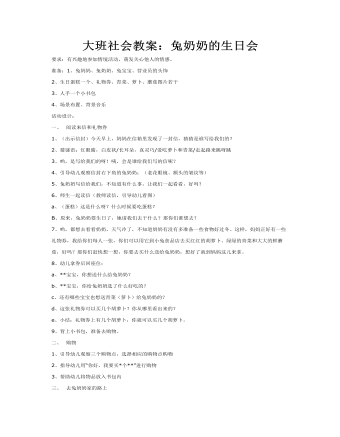
大班社会教案:兔奶奶的生日会
一、 阅读来信和礼物券 1、(出示信封)今天早上,妈妈在信箱里发现了一封信,猜猜是谁写给我们的? 2、猜谜语:红眼睛,白皮袄/长耳朵,真灵巧/爱吃萝卜和青菜/走起路来跳呀跳 3、哟,是写给我们的呀!咦,会是谁给我们写的信呢? 4、引导幼儿观察信封右下角的兔奶奶:(老花眼镜、额头的皱纹等) 5、兔奶奶写信给我们,不知道有什么事,让我们一起看看,好吗? 6、师生一起读信(教师读信,引导幼儿看图) a、(蛋糕)这是什么呀?什么时候要吃蛋糕? B、原来,兔奶奶要生日了,她请我们去干什么?那你们谁想去?

